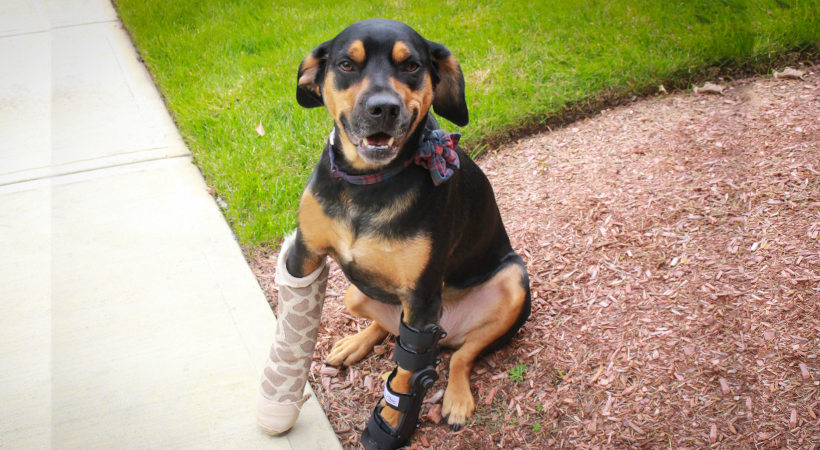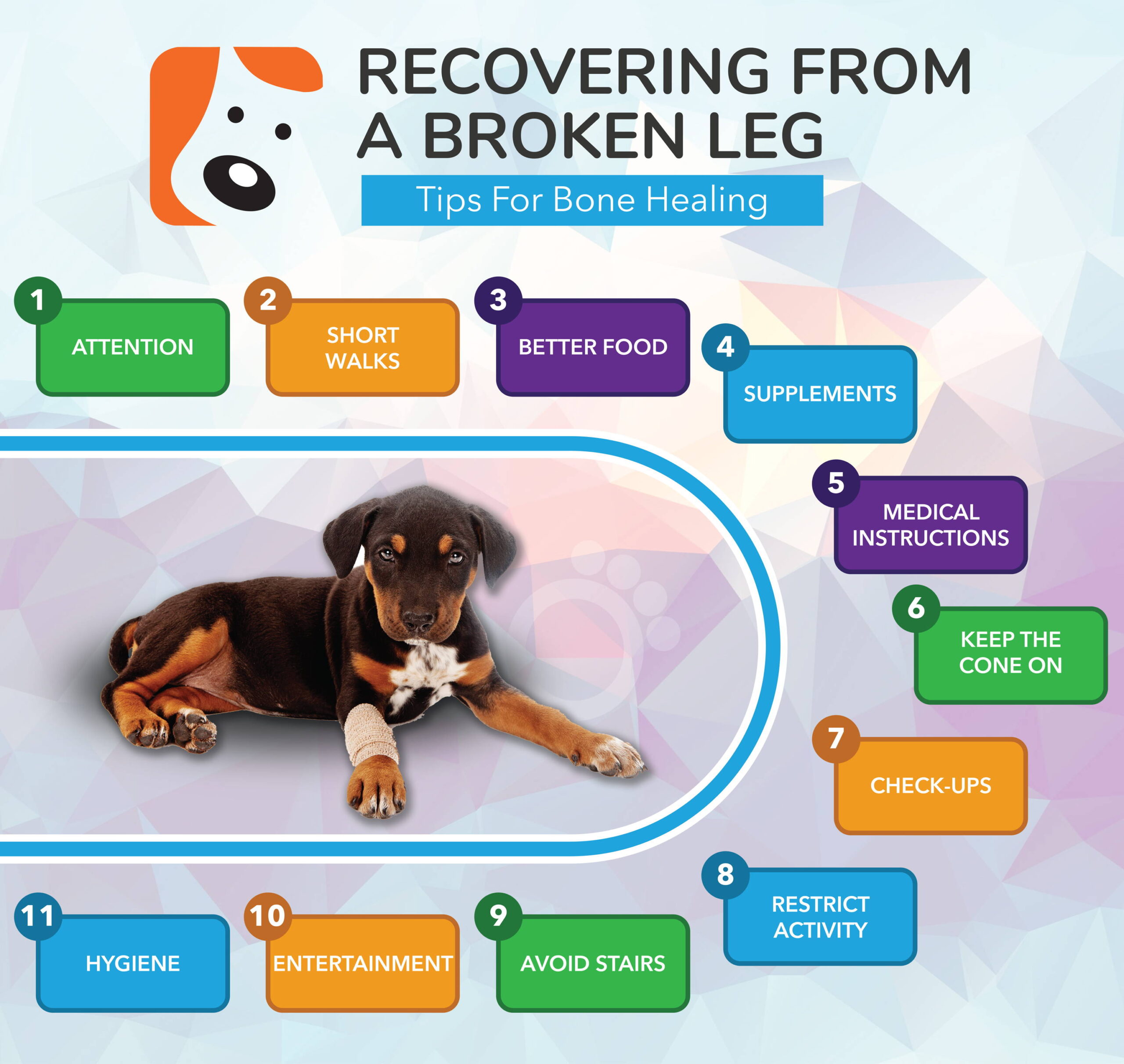A dog with a broken leg is unlikely to walk on the affected limb. The severity of the break and the dog’s pain will cause limping and weight avoidance.
When observing a dog with a broken leg, it is vital to understand their behavior and physical signs to provide appropriate care. Canine leg fractures may lead to limping, excessive licking, and obvious pain. Seeking immediate veterinary care is crucial to assess the extent of the injury and provide necessary treatment.
Additionally, understanding the signs of a sprained leg versus a broken leg is essential for pet owners to recognize and address the issue promptly. Knowing how to support and assist a dog with a broken leg is vital for their well-being and recovery.

Credit: k9carts.com
Symptoms Of A Broken Leg In A Dog
Recognizing the symptoms of a broken leg in a dog is crucial for early detection and proper treatment. Understanding the signs can help pet owners act swiftly and seek veterinary care. Below are the key symptoms to look for when assessing a dog for a broken leg:
Visible Changes
A dog’s broken leg may appear deformed or bent at an odd angle, especially if the pieces of a comminuted fracture have drifted out of their normal alignment.
Swelling And Bruising
Swelling and bruising may be apparent in the affected area of the leg. In an open fracture, you might even see the end of the bone poking out of the open wound in the skin.
Pain Indicators
If your dog has a broken bone, it’s not likely they will put any weight on the affected limb. They may also exhibit signs of pain, such as whimpering or yelping when attempting to move or when the affected limb is touched.
Differentiating Between Broken And Sprained Legs
A dog with a broken leg will likely not put any weight on the affected limb and may appear deformed or swollen. On the other hand, a sprained leg can cause limping and changes in gait. It’s important to seek veterinary attention for proper diagnosis and treatment.
Changes In Gait
When a dog experiences a broken leg, their natural gait will typically be affected. You may notice that your furry friend starts to limp or favor one leg over the other. This change in gait is a clear indication that something is not right. The dog will try to shift their weight to the uninjured leg to alleviate the pain in the broken leg, leading to an altered walking pattern. Keep a close eye on your dog’s movements to determine if their gait has been altered.
Weight Bearing
One effective way to differentiate between a broken leg and a sprained leg in a dog is by observing their weight-bearing behavior. In the case of a broken leg, the affected limb is unlikely to bear any weight. Your canine companion will avoid putting any pressure on the injured leg due to the pain and discomfort they are experiencing. On the other hand, a dog with a sprained leg may still bear some weight on the affected limb, albeit with some difficulty.
Sounds Of Pain
Pay attention to any signs of pain your dog might exhibit, particularly when they move or put pressure on their leg. While dogs cannot verbally communicate their pain, they often express their discomfort through vocalizations. If you notice your furry friend crying out or whimpering while walking, playing, or running, it could be an indicator of a broken leg rather than a sprained leg. These sounds of pain provide valuable insight into the severity of the injury and can help you determine the appropriate course of action.
It is crucial to differentiate between a broken leg and a sprained leg in dogs to ensure they receive the necessary treatment and care. Observing changes in gait, weight-bearing patterns, and sounds of pain are essential in making an accurate assessment. If you suspect your dog has a broken leg, it is vital to seek veterinary attention promptly to minimize pain and alleviate any potential complications.
Treatment Options For A Dog’s Broken Leg
A broken leg in a dog is a serious injury that requires proper treatment to ensure a full recovery and alleviate pain. Depending on the severity of the break, there are several treatment options available. The most important step is to seek veterinary intervention to properly assess the injury and determine the best course of action.
Veterinary Intervention
Veterinary intervention is crucial when it comes to treating a dog’s broken leg. A veterinarian will conduct a thorough examination, including x-rays, to accurately diagnose the fracture and assess its severity. They will then recommend the appropriate treatment plan. It is important not to attempt any treatment without professional guidance, as improper handling can lead to further complications.
Surgical Procedures
If the fracture is severe or complex, surgical procedures may be necessary to repair the dog’s broken leg. Common surgical interventions include:
- Internal fixation: Surgeons use pins, plates, or screws to realign and stabilize the fractured bone.
- External fixation: The fracture is stabilized using an external device such as a metal plate or frame.
- Amputation: In severe cases where the leg cannot be saved, amputation may be the only option to alleviate pain and ensure the dog’s quality of life.
The specific surgical procedure will depend on the type and location of the fracture, as well as the overall health of the dog.
Non-surgical Approaches
Non-surgical approaches may be considered for less severe fractures or cases where surgery is not recommended. These approaches include:
- Rest and immobilization: The affected leg is typically immobilized using a splint, cast, or brace to allow the bone to heal.
- Pain management: Veterinarians may prescribe pain medication or recommend alternative therapies such as acupuncture or physical therapy to alleviate discomfort and promote healing.
- Follow-up care: Regular check-ups and monitoring are crucial in non-surgical cases to ensure proper healing and identify any potential complications.
It is important to note that the specific treatment approach will depend on various factors, including the dog’s age, overall health, and the location and type of fracture.
Regardless of the treatment option chosen, it is essential to follow the veterinarian’s instructions and provide proper care during the recovery period. This may include restrictions on activity, ensuring a comfortable environment, and administering any prescribed medication.
Credit: boneocanine.com
Recovery Process For Dogs With Broken Legs
When a dog has a broken leg, they typically won’t put weight on it, resulting in limping to avoid pain. Treating with a cast or splint helps stabilize the bones during the recovery process, enabling dogs to heal and eventually walk normally again.
Rehabilitation And Physiotherapy
A crucial aspect of the recovery process for dogs with broken legs is rehabilitation and physiotherapy. Just like humans, dogs require specialized care and exercises to regain their strength and mobility after a leg injury. Rehabilitation therapies such as hydrotherapy, range of motion exercises, and therapeutic ultrasound can help alleviate pain, reduce swelling, and promote healing. These therapies are tailored to the individual dog’s needs and are overseen by trained professionals.
Monitoring Healing Progress
It is important to closely monitor the healing progress of a dog with a broken leg. Regular check-ups with a veterinarian are necessary to ensure that the bones are properly aligning and that there are no complications. X-rays may be taken periodically to assess the healing process. Monitoring involves observing the dog’s gait, range of motion, and overall comfort level. Any abnormalities or setbacks should be reported to the veterinarian immediately for prompt intervention.
Precautions To Avoid Re-injury
To prevent re-injury after a dog has recovered from a broken leg, certain precautions need to be taken. It is important to provide a safe and controlled environment for the dog, minimizing chances of accidents or falls. Avoid high-impact activities such as jumping or rough play that could put excessive strain on the healed leg. Using a protective splint or brace may be necessary during the recovery period to provide additional support and stability. Regular exercise, under the guidance of a veterinarian, helps maintain muscle strength and joint mobility, reducing the risk of re-injury.
Factors Affecting A Dog’s Ability To Walk On A Broken Leg
A dog with a broken leg may not put weight on the affected limb and will likely limp to reduce pain. Severe breaks can cause deformity or swelling, making walking challenging. Treatment like casting may be needed for dogs with stable fractures.
Severity Of Fracture
In cases of severe fractures, dogs are less likely to walk due to the extreme pain and structural damage to the bone. The severity of the fracture directly impacts the dog’s ability to bear weight on the affected limb.
Dog’s Pain Threshold
The pain threshold of a dog varies, and some dogs may exhibit signs of discomfort even with minor fractures. Dogs with a low pain threshold may struggle to walk on a broken leg, while others with a higher pain tolerance may continue to move despite the injury.
Individual Healing Capacity
Each dog’s healing capacity differs, affecting their ability to walk on a broken leg. Some dogs may heal quickly and adapt to the injury, enabling them to move around despite the fracture. On the other hand, dogs with slower healing processes may find it challenging to walk until the bone has adequately repaired.
Understanding these factors is crucial in assessing a dog’s ability to walk on a broken leg and providing appropriate care and treatment.
Myths Vs. Reality About Dogs Walking On Broken Legs
Myth: Dogs Will Naturally Avoid Walking On Broken Limbs
Dogs do not always avoid walking on broken limbs, despite the common myth. In reality, dogs may still attempt to move, but they often do so with caution.
Reality: Dogs May Still Attempt To Move With Caution
Even with a broken leg, dogs may try to move, but they typically do so with great care to minimize discomfort and pain.
Preventive Measures To Minimize The Risk Of Leg Injuries In Dogs
Dogs, like any other living creature, are susceptible to leg injuries. Taking preventive measures is crucial to minimize the risk of such injuries and ensure your furry friend’s optimal well-being.
Regular Vet Check-ups
One of the key preventive measures for minimizing the risk of leg injuries in dogs is to schedule regular check-ups with a trusted veterinarian. These check-ups can help in early detection of any underlying health issues and maintain their overall physical condition. When a dog is at their ideal weight, it significantly reduces the strain on their legs, thus decreasing the likelihood of injuries.
Maintaining A Dog’s Ideal Weight
Maintaining a dog’s ideal weight is essential in preventing leg injuries. Excess weight can put additional strain on a dog’s legs, leading to potential injuries. A balanced diet and regular exercise are crucial to keep your canine companion at a healthy weight, ultimately reducing the risk of leg injuries.
Avoiding Physical Overexertion
Avoiding physical overexertion is crucial in preventing leg injuries in dogs. Engaging in excessive or intense physical activities can strain a dog’s legs, leading to possible injuries. It’s important to provide appropriate exercise and playtime that does not overexert their legs, ensuring their safety and well-being.
Incorporating these preventive measures into your dog’s routine plays a vital role in minimizing the risk of leg injuries, allowing them to lead a happy, healthy, and active life.

Credit: www.walkinpets.com
Frequently Asked Questions
How Can I Tell If My Dog’s Leg Is Broken Or Just Sprained?
If your dog’s leg appears deformed, swollen, bruised, or if bone is visible, it may be broken. Limping and weight shifting indicate a sprain.
Will A Dog Walk On A Sprained Leg?
A dog with a sprained leg may limp or change its gait to lessen pain and shift weight to the uninjured paw.
Can A Dog Still Move A Broken Leg?
A dog with a broken leg may still move, but they will most likely limp and avoid using the affected limb due to pain.
Can A Dog’s Broken Leg Heal On Its Own?
A dog’s broken leg should not heal on its own – they need veterinary care to mend properly.
Conclusion
It’s essential to seek immediate veterinary care if you suspect your dog has a broken leg. Dogs may try to walk on a broken leg, but it’s not recommended as it can worsen the injury. A professional assessment and appropriate treatment are crucial for the well-being of your furry companion.




